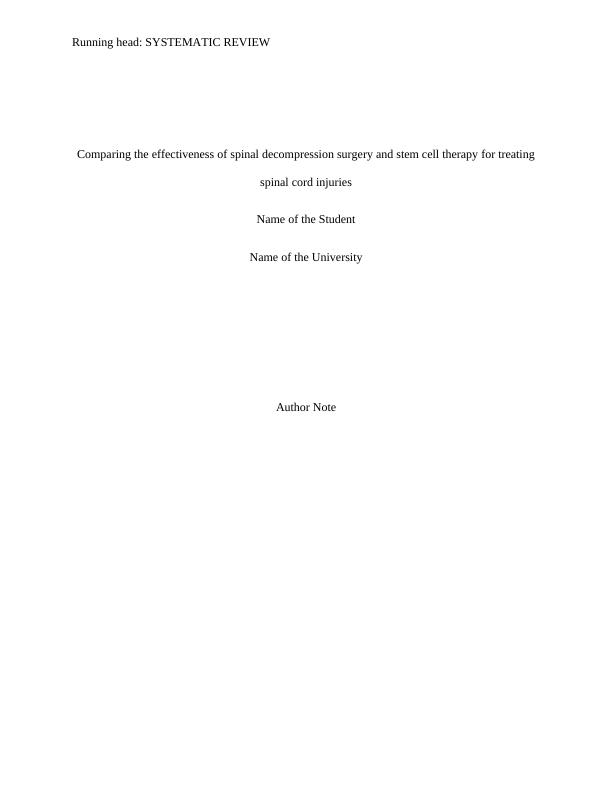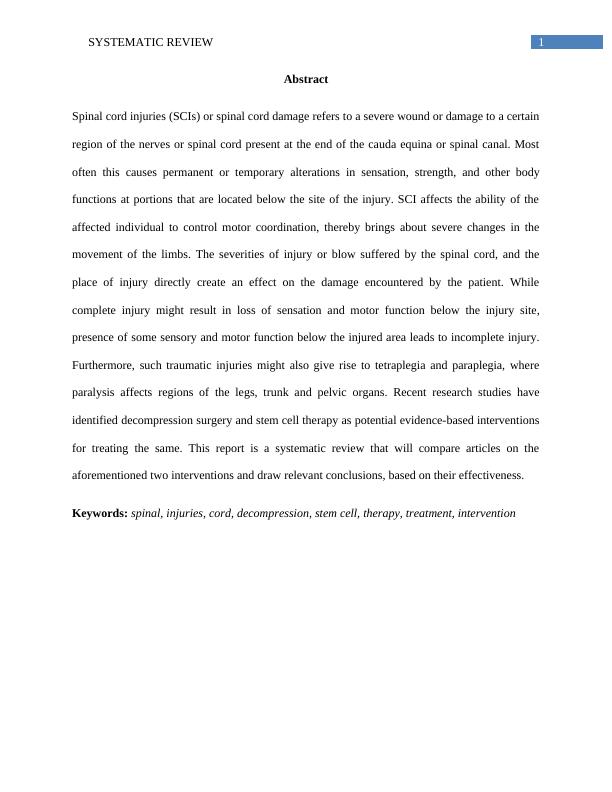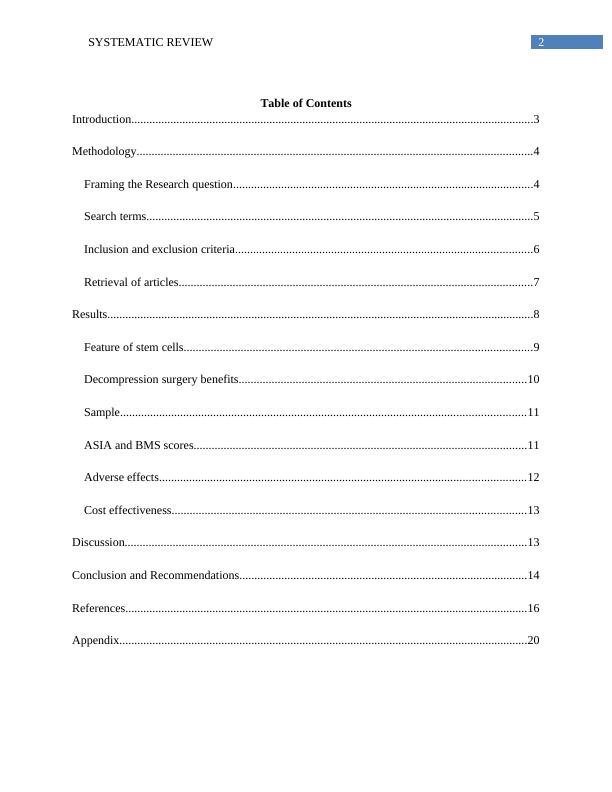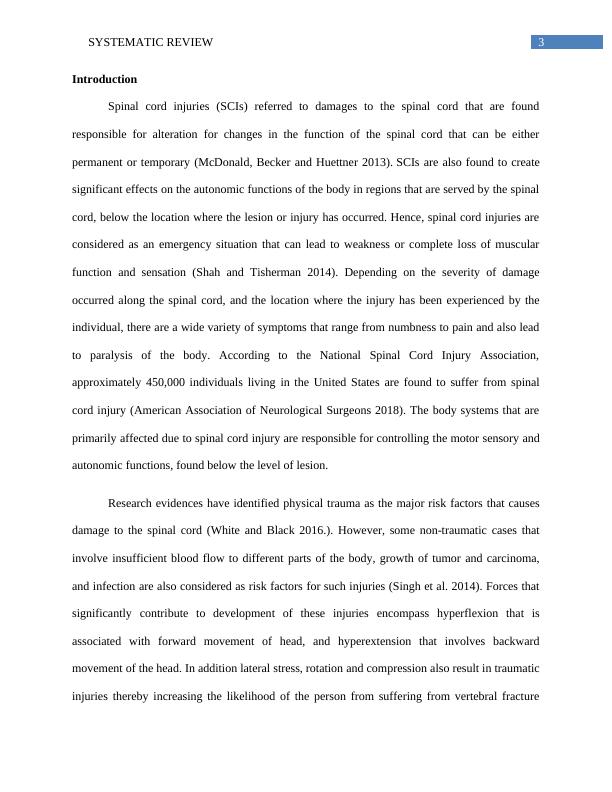Introduction to Systematic Review (PDF)
20 Pages5248 Words22 Views
Added on 2021-05-31
Introduction to Systematic Review (PDF)
Added on 2021-05-31
ShareRelated Documents
Running head: SYSTEMATIC REVIEW
Comparing the effectiveness of spinal decompression surgery and stem cell therapy for treating
spinal cord injuries
Name of the Student
Name of the University
Author Note
Comparing the effectiveness of spinal decompression surgery and stem cell therapy for treating
spinal cord injuries
Name of the Student
Name of the University
Author Note

1SYSTEMATIC REVIEW
Abstract
Spinal cord injuries (SCIs) or spinal cord damage refers to a severe wound or damage to a certain
region of the nerves or spinal cord present at the end of the cauda equina or spinal canal. Most
often this causes permanent or temporary alterations in sensation, strength, and other body
functions at portions that are located below the site of the injury. SCI affects the ability of the
affected individual to control motor coordination, thereby brings about severe changes in the
movement of the limbs. The severities of injury or blow suffered by the spinal cord, and the
place of injury directly create an effect on the damage encountered by the patient. While
complete injury might result in loss of sensation and motor function below the injury site,
presence of some sensory and motor function below the injured area leads to incomplete injury.
Furthermore, such traumatic injuries might also give rise to tetraplegia and paraplegia, where
paralysis affects regions of the legs, trunk and pelvic organs. Recent research studies have
identified decompression surgery and stem cell therapy as potential evidence-based interventions
for treating the same. This report is a systematic review that will compare articles on the
aforementioned two interventions and draw relevant conclusions, based on their effectiveness.
Keywords: spinal, injuries, cord, decompression, stem cell, therapy, treatment, intervention
Abstract
Spinal cord injuries (SCIs) or spinal cord damage refers to a severe wound or damage to a certain
region of the nerves or spinal cord present at the end of the cauda equina or spinal canal. Most
often this causes permanent or temporary alterations in sensation, strength, and other body
functions at portions that are located below the site of the injury. SCI affects the ability of the
affected individual to control motor coordination, thereby brings about severe changes in the
movement of the limbs. The severities of injury or blow suffered by the spinal cord, and the
place of injury directly create an effect on the damage encountered by the patient. While
complete injury might result in loss of sensation and motor function below the injury site,
presence of some sensory and motor function below the injured area leads to incomplete injury.
Furthermore, such traumatic injuries might also give rise to tetraplegia and paraplegia, where
paralysis affects regions of the legs, trunk and pelvic organs. Recent research studies have
identified decompression surgery and stem cell therapy as potential evidence-based interventions
for treating the same. This report is a systematic review that will compare articles on the
aforementioned two interventions and draw relevant conclusions, based on their effectiveness.
Keywords: spinal, injuries, cord, decompression, stem cell, therapy, treatment, intervention

2SYSTEMATIC REVIEW
Table of Contents
Introduction......................................................................................................................................3
Methodology....................................................................................................................................4
Framing the Research question....................................................................................................4
Search terms.................................................................................................................................5
Inclusion and exclusion criteria...................................................................................................6
Retrieval of articles......................................................................................................................7
Results..............................................................................................................................................8
Feature of stem cells....................................................................................................................9
Decompression surgery benefits................................................................................................10
Sample.......................................................................................................................................11
ASIA and BMS scores...............................................................................................................11
Adverse effects..........................................................................................................................12
Cost effectiveness......................................................................................................................13
Discussion......................................................................................................................................13
Conclusion and Recommendations................................................................................................14
References......................................................................................................................................16
Appendix........................................................................................................................................20
Table of Contents
Introduction......................................................................................................................................3
Methodology....................................................................................................................................4
Framing the Research question....................................................................................................4
Search terms.................................................................................................................................5
Inclusion and exclusion criteria...................................................................................................6
Retrieval of articles......................................................................................................................7
Results..............................................................................................................................................8
Feature of stem cells....................................................................................................................9
Decompression surgery benefits................................................................................................10
Sample.......................................................................................................................................11
ASIA and BMS scores...............................................................................................................11
Adverse effects..........................................................................................................................12
Cost effectiveness......................................................................................................................13
Discussion......................................................................................................................................13
Conclusion and Recommendations................................................................................................14
References......................................................................................................................................16
Appendix........................................................................................................................................20

3SYSTEMATIC REVIEW
Introduction
Spinal cord injuries (SCIs) referred to damages to the spinal cord that are found
responsible for alteration for changes in the function of the spinal cord that can be either
permanent or temporary (McDonald, Becker and Huettner 2013). SCIs are also found to create
significant effects on the autonomic functions of the body in regions that are served by the spinal
cord, below the location where the lesion or injury has occurred. Hence, spinal cord injuries are
considered as an emergency situation that can lead to weakness or complete loss of muscular
function and sensation (Shah and Tisherman 2014). Depending on the severity of damage
occurred along the spinal cord, and the location where the injury has been experienced by the
individual, there are a wide variety of symptoms that range from numbness to pain and also lead
to paralysis of the body. According to the National Spinal Cord Injury Association,
approximately 450,000 individuals living in the United States are found to suffer from spinal
cord injury (American Association of Neurological Surgeons 2018). The body systems that are
primarily affected due to spinal cord injury are responsible for controlling the motor sensory and
autonomic functions, found below the level of lesion.
Research evidences have identified physical trauma as the major risk factors that causes
damage to the spinal cord (White and Black 2016.). However, some non-traumatic cases that
involve insufficient blood flow to different parts of the body, growth of tumor and carcinoma,
and infection are also considered as risk factors for such injuries (Singh et al. 2014). Forces that
significantly contribute to development of these injuries encompass hyperflexion that is
associated with forward movement of head, and hyperextension that involves backward
movement of the head. In addition lateral stress, rotation and compression also result in traumatic
injuries thereby increasing the likelihood of the person from suffering from vertebral fracture
Introduction
Spinal cord injuries (SCIs) referred to damages to the spinal cord that are found
responsible for alteration for changes in the function of the spinal cord that can be either
permanent or temporary (McDonald, Becker and Huettner 2013). SCIs are also found to create
significant effects on the autonomic functions of the body in regions that are served by the spinal
cord, below the location where the lesion or injury has occurred. Hence, spinal cord injuries are
considered as an emergency situation that can lead to weakness or complete loss of muscular
function and sensation (Shah and Tisherman 2014). Depending on the severity of damage
occurred along the spinal cord, and the location where the injury has been experienced by the
individual, there are a wide variety of symptoms that range from numbness to pain and also lead
to paralysis of the body. According to the National Spinal Cord Injury Association,
approximately 450,000 individuals living in the United States are found to suffer from spinal
cord injury (American Association of Neurological Surgeons 2018). The body systems that are
primarily affected due to spinal cord injury are responsible for controlling the motor sensory and
autonomic functions, found below the level of lesion.
Research evidences have identified physical trauma as the major risk factors that causes
damage to the spinal cord (White and Black 2016.). However, some non-traumatic cases that
involve insufficient blood flow to different parts of the body, growth of tumor and carcinoma,
and infection are also considered as risk factors for such injuries (Singh et al. 2014). Forces that
significantly contribute to development of these injuries encompass hyperflexion that is
associated with forward movement of head, and hyperextension that involves backward
movement of the head. In addition lateral stress, rotation and compression also result in traumatic
injuries thereby increasing the likelihood of the person from suffering from vertebral fracture

End of preview
Want to access all the pages? Upload your documents or become a member.
Related Documents
Sample Assignment on Spinal Cord Injurieslg...
|16
|1807
|380
Treatment of Spinal Cord Injury with Epidural Electrical Stimulationlg...
|6
|1216
|386
Therapeutic Interventions After Spinal Cord Injurylg...
|6
|1674
|63
Spinal Cord Injury: Causes, Symptoms, Treatment and Managementlg...
|5
|1128
|252
[PDF] Sexual rights and bodily integrity as human rightslg...
|4
|972
|24
Clinical Reasoning Skill Question and Answer 2022lg...
|10
|3062
|23
